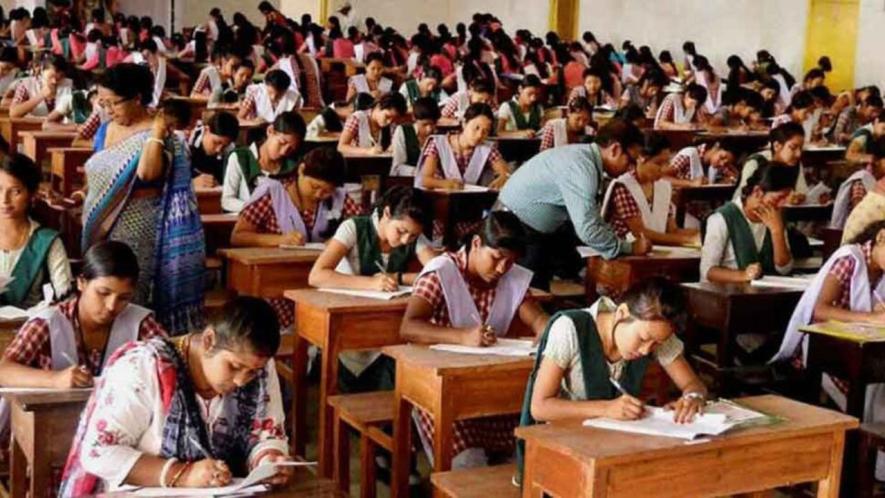CUET: Reform or Gatekeeping of Privilege?

Representational Image. Image Courtesy: Wikimedia Commons
In a recent commentary, the Common University Entrance Test (CUET) has been defended as an ostensibly necessary and inclusive reform in India’s higher education landscape. Proponents argue that the shift from fragmented board-based admissions and separate entrance exams to a singular all-India test, marks progress toward fairness and standardisation. This narrative suggests that CUET reduces the influence of inflated board marks, creates a level playing field, and integrates marginalised students into elite academic spaces. It further maintains that logistical disruptions are temporary and that the system is evolving toward greater efficiency.
However, such claims overlook the deeper structural exclusions that CUET institutionalises. While the rhetoric of inclusion seems compelling, both its substance and the reality of its implementation tell a more troubling story of institutionalised inequality. The standardisation of admission through a single, high-stakes examination does not erase inequality; rather, it reshapes and reinforces it through new mechanisms of exclusion rooted in exploitation and oppression.
The most prominent argument in favour of CUET is that it offers an objective and uniform alternative to the disparate marking practices of more than sixty school boards. There is no denying that inflation in marks and inconsistency in board scores are concerns. Yet, replacing one flawed metric with another that may be worse does not necessarily lead to greater fairness. The CUET format privileges students who are already embedded in learning ecosystems that prepare them for competitive tests. These ecosystems, marked by private coaching, urban schooling, stable internet access, and supportive home environments, (which crucially, presupposes a high family income as a necessary condition), remain inaccessible to large segments of the population, particularly those from rural, low-income, and non-English-speaking backgrounds. A so-called level playing field presupposes equal access to the conditions necessary to perform well in these tests. In the absence of such conditions, the field remains tilted, only now under the guise of purported equality.
One of the more problematic assertions by supporters of CUET is that CUET reduces reliance on the coaching industry since it aligns with NCERT content (whose syllabi since 2014 are becoming ever more distant from scientific pedagogy). On the contrary, what we are witnessing is the rapid expansion of CUET-specific coaching across the country. The pressure of a single-shot, high-stakes test has fuelled the demand for coaching that claims to decode the format, provide mock tests, and simulate testing conditions. This is not a retreat from coaching culture but its reconfiguration on an all-India scale. In effect, a student’s performance increasingly tends to reflect the affordability of preparatory infrastructure rather than academic capability which is determined by diverse factors. Far from being a corrective to inequality, CUET risks amplifying the privileges of those already advantaged within the education system.
Moreover, if there is only one entrance test then a student whose performance is below their potential on that one day will not have a chance to make a comeback. Importantly, diversity in entrance tests and other modes of admission allows education systems to be aligned with the inherent diversity of students. Seeking to curb diversity, apart from being against the constitution of India, is also not conducive to the furthering of innovation.
The defence of CUET also leans heavily on its supposed respect for federalism through the inclusion of regional languages and subject choice. Yet this narrative is difficult to reconcile with the structure of the exam. Despite the availability of question papers in multiple languages, the curriculum is overwhelmingly based on NCERT textbooks, which reflect the content and pedagogical priorities of the Central Board of Secondary Education (CBSE). Many state education boards have distinct syllabi, linguistic orientations, and pedagogical traditions.
The imposition of a Centrally determined syllabus, even when translated, constitutes a form of epistemic violence that marginalises state-level educational frameworks. A more basic question is whether it is constitutional to demand that the union government of India’s priorities regarding admission procedures in educational institutions be imposed on educational institutions funded by state governments.
In fact, the mismanagement of the examination process has become emblematic of the system’s deeper dysfunction. A particularly revealing instance occurred at several CUET centres in Kanpur, where students were handed question papers in the wrong language medium, including English papers instead of Hindi, leading to confusion, emotional distress, and ultimately the cancellation and rescheduling of the exam. This was not an isolated incident but part of a wider pattern of administrative failure, one that erodes trust and inflicts psychological and logistical costs on candidates. Such incidents starkly expose the mismatch between the grand narrative of reform and the fragile realities of execution on the ground.
For students who travel long distances, often at great expense and personal risk, only to face this kind of disarray, the promise of a fair and unified system rings hollow. The burden of these failures is not equally distributed; it falls disproportionately on those with the least capacity to absorb the consequences namely, the socially oppressed.
The logistical challenges that have accompanied CUET since its inception, ranging from paper leaks to last-minute changes in exam schedules, are routinely described as teething troubles or inevitable disruptions in a large-scale system. However, such framing fails to recognise the uneven burden these disruptions impose.
Students from privileged backgrounds may have the flexibility to adjust their schedules, postpone other plans, or wait out delays. Those from economically vulnerable households, however, are more vulnerable. Travel costs, loss of income, the inability to reschedule local obligations, and emotional strain can collectively derail the prospects of students who are already trying to navigate a precarious educational journey. To characterise these systemic failures as mere “hiccups” is to trivialise the structural dysfunction that underpins them.
Another dimension that warrants closer examination is the gendered impact of CUET. The format and implementation of the exam impose several indirect barriers for young women, especially those from socially conservative or economically constrained households. The centralisation of testing centres often requires intercity travel, which may not be considered safe for female students in the absence of government support. Coaching centres, which now play a pivotal role in shaping CUET outcomes are often located far from home and may not offer gender-sensitive spaces.
The increased stress and uncertainty surrounding results may further dissuade families from allowing young women to pursue higher education. Suggesting that better information campaigns can overcome these obstacles falsely reduces a structural problem that requires the allocation of government resources to a matter of raising awareness.
It is also important to examine the consequences of CUET for university life more broadly. Reports of vacant seats are being interpreted as signs of greater student choice, when in fact they point to poor synchronisation of counselling processes and systemic inefficiencies. The delay in admissions has led to a contraction of the academic calendar, particularly affecting activities that are central to the university experience, such as cultural festivals, student clubs, co-curricular engagement and maintaining diversity in the teaching-learning experience. Their erosion underlines the extent to which CUET has disrupted not only admissions but also the rhythm and richness of educational experiences.
The shift to online classes in many colleges, especially in response to mismatch between infrastructure and student intake, is being portrayed as an experiment in flexibility. Yet this further reveals a diminished understanding of undergraduate education. Online learning, especially when adopted under compulsion, cannot substitute for the pedagogical interactions, peer learning, and mentorship that define meaningful education. If infrastructure cannot keep pace with policy, the result is not innovation but deterioration.
Perhaps the most troubling aspect of the discourse around CUET is the attempt to frame any critique as resistance to progress. Any opposition to CUET is dismissed as nostalgia for a supposedly broken past. This binary between centralised modernity and decentralised backwardness is at best intellectually dishonest.
There are several alternative models that could have been explored including normalisation of scores across boards to remove skewness, meaningfully weighted combinations of scores of board results and entrance tests, decentralised university-level admissions with safeguards for diversity etc. The institutionalisation of these alternatives requires deeper engagement with the complexities and diversity of the Indian education system, rather than a rush to impose an exclusionary homogeneity in the name of ostensible efficiency.
CUET does not resolve the deep-rooted crisis of inequality in higher education admissions. Instead, by institutionalising a centralised test that privileges those already advantaged; urban, affluent, and CBSE-aligned, it undermines the constitutional autonomy of Indian states and dilutes the rich educational diversity that characterises India’s federal structure. It offers a façade of fairness while reproducing exclusion in more opaque and technocratic ways.
If inclusion is the intended goal, then the means must embody that principle through meaningful decentralisation, pedagogical pluralism, increased public investment in education, and a readiness to embrace complexity rather than suppress it. Authentic reform must engage with the lived realities of marginalised students, not bypass them. Without such a commitment, CUET risks becoming not a tool of opportunity, but an instrument of calibrated gatekeeping masquerading as meritocracy.
Shirin Akhter is Associate Professor at Zakir Husain Delhi College, University of Delhi. C Saratchand is Professor, Department of Economics, Satyawati College, University of Delhi. The views are personal.
Get the latest reports & analysis with people's perspective on Protests, movements & deep analytical videos, discussions of the current affairs in your Telegram app. Subscribe to NewsClick's Telegram channel & get Real-Time updates on stories, as they get published on our website.























